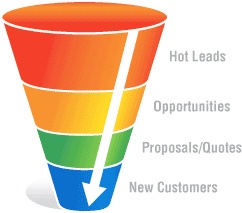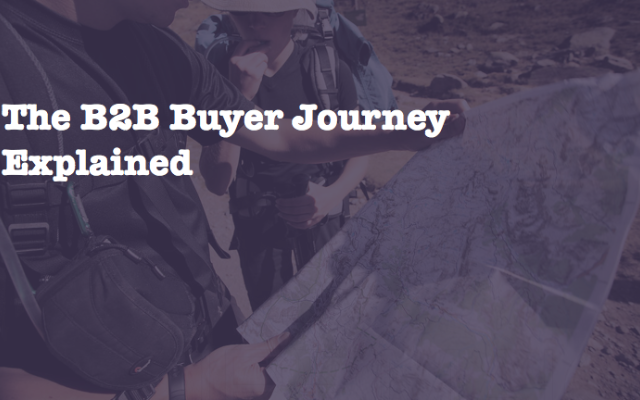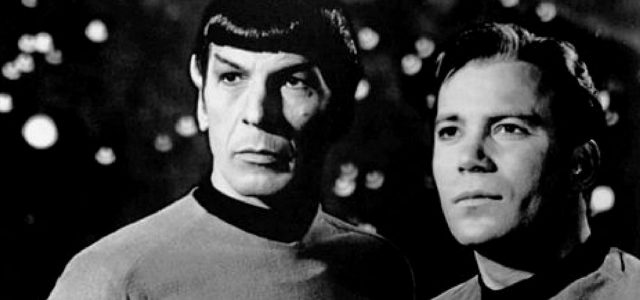The Buyer Journey is a new marketing construct that replaces the classic Marketing Funnel. You know the one.

Tactically, this funnel is fine for measuring individual campaigns (e.g. How’s this landing page doing?), but the concept no longer works for strategic B2B marketers. This is because the way that prospects purchase products and services from other businesses has fundamentally changed with the evolution of the web.
Bouncing Between Search, Social, Content
Search, social media, and the abundance of digital content that has become available to buyers online over the past ten years has resulted in new researching/purchasing behaviors. People use Google to search for solutions to their challenges; they ping their social networks for advice; and they look to evaluate potential products and vendors on their own, without talking to a salesperson.
Ask Forrester, CEB, SiriusDecisions, and the other research houses, and they’ll tell you that between 60% and 90% of the “buyer’s journey” is now self-guided.
And when buyers guide themselves, you’d better believe they’re not going in a straight line (down your ‘funnel’). They’re bouncing back and forth between buying stages (more of a ‘journey’). I might think this or that solution category is best suited for my challenge; however, once I get through the Comparison stage, I may realize I was wrong, and now I need to jump back to the Consideration stage.
I may hit the Evaluation stage (think of a free 30-day software trial), realize that the tool doesn’t have a feature that I require, and bounce back to the Comparison stage, or even all the way back to Consideration.
This doesn’t even touch on the fact that, more than ever before, B2B purchase decisions are made by teams, not by individuals. And teams have a way of getting off track, diverting the process even more from a clean, net one-way funnel.
This “bouncing” behavior has become incredibly common. Yet it breaks the Funnel construct. If marketers want to be successful today, we need to align on a Buyer Journey construct when designing our marketing strategies.

Is the role of Sales in B2B industries dead?
Of course not. It’s just taking on a new form. Once the buyer makes it through the early and middle stages of their Buyer Journey – and Marketing has done their job by educating and engaging them at each stage – Sales takes over somewhere during the Evaluation and Decision stages with their own funnel.
It usually looks something like this:

And Sales teams can attest to the fact that numbers are down, hitting cold call quotas is getting harder and harder, and they rely on Marketing to send them good quality leads more than ever before.
And so, when Sales says, “I need more leads!”, Marketing reacts. They adjust the MQL criteria to pump more new leads into the CRM and over to the Sales team.
But why doesn’t this work?
Because those new leads aren’t better leads; they’re the same leads as before, just being sent over to Sales earlier in their buying process, when they’re not yet ready to talk to a salesperson (they’re still doing their own research, remember?). So those leads don’t perform, and Sales says to Marketing “I need better leads!”
All the while, the Marketing team is trying to do more with less, as they deal with big changes to AdWords, cope with the ad blocker crisis, try to prevent fraud, and look for more affordable ways to generate good leads.
This all causes frustration.
Mapping The Buyer Journey
By switching over to a Buyer Journey model, marketers will be more attuned to actual customer-centric strategies (instead of shoehorning them into the old funnel mentality). Their marketing strategies will also be more aligned with the Sales team, which is mission-critical today.
If marketers build out more accurate Buyer Personas, map those personas to the stages of their Buyer Journey, document that Buyer Journey and circulate it with their teams, they will be poised for success.
This results in better communication; clearer goals and objectives; a more holistic strategy for inbound marketing through efficient and effective lead generating channels like Search, Social, and Content; and tactics that are designed specifically to accelerate each stage of the Buyer Journey.
Doesn’t that sound like a great world to be a marketer?
This article originally appears on the Socialight Insights Blog.
Article by channel:
Everything you need to know about Digital Transformation
The best articles, news and events direct to your inbox
Read more articles tagged: Customer Journey, Featured







